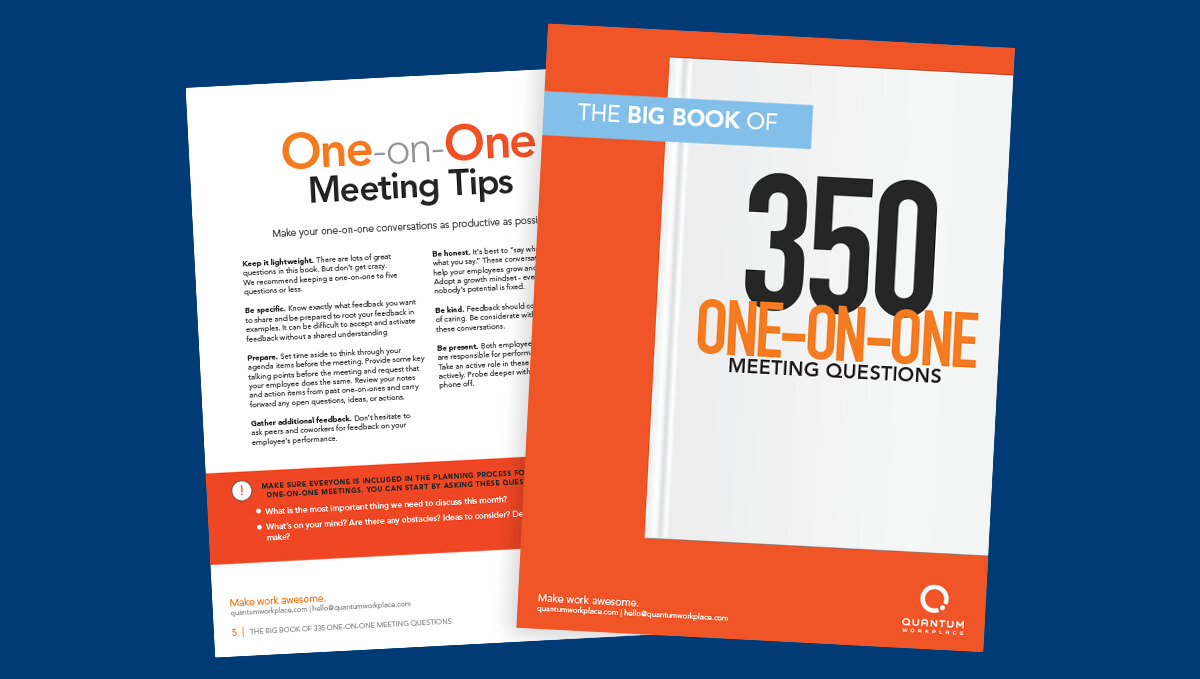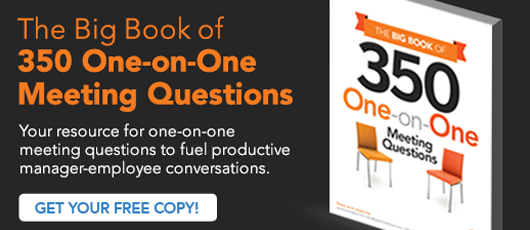How to Have a Successful First One-on-One With An Employee
 One-on-one meetings are a crucial part of the manager’s toolbox. They are an opportunity to build manager-employee relationships and ensure the team is aligned and on track.
One-on-one meetings are a crucial part of the manager’s toolbox. They are an opportunity to build manager-employee relationships and ensure the team is aligned and on track.
A study by Microsoft Workplace Analytics found that “employees who got little to no one-on-one time with their manager were more likely to be disengaged. On the flip side, those who get twice the number of one-on-ones with their manager relative to their peers are 67% less likely to be disengaged.”
That’s why it’s important to get your first one-on-one meeting right.
The first one-on-one meeting with your employees sets the tone for the relationship and can set the course for your employees’ long-term performance and engagement.
Below we’ll cover how to have a successful first one-on-one with an employee, plus the first one-on-one questions you should ask.
- How to have your first one-on-one with an employee
- The first one-on-one questions to ask
How to have your first one-on-one with an employee
Whether you’re a new manager or you’re bringing on new hires, the first one-on-ones with your team are about building strong foundations.
For new employees, the first one-on-one meeting is an opportunity to set expectations and introduce the organization and its culture. For tenured employees, those first one-on-ones establish a relationship that both of you can build on.
In other words, first impressions matter. So how do you make sure your one-on-ones are successful?
Managers should be thinking about:
- Establishing short- and long-term goals
- Understanding employee preferences (such as recognition, engagement, development)
- Uncovering initial perceptions of the organization, their team, and their role
1. Invite your employee to have a one-on-one meeting.
The first step to hosting a one-on-one is to communicate with your employee. If they are a new hire, you’ll want to meet with them the first week to make sure they are oriented.
Send an email invite briefly explaining the purpose of the meeting and what you want to cover so they know what to expect and can come prepared. Include the date and time you want to meet as well as how often you want to meet going forward. (Weekly or monthly one-on-ones are a good place to start. Talk with your employee to find a cadence that works for both of you).
Then, keep your engagement. Do not cancel your one-on-one. If you absolutely can’t meet at the appointed time, reschedule. This is important for any one-on-one, but especially for your first meeting, it’s critical you show up on time.
Remember, the first one-on-one sets the tone for the relationship. Canceling a meeting is disrespectful of their time and shows you don’t value them—not a great way to start.
2. Set up a shared one-on-one document.
Keep a clear record of your conversations from day one with a shared meeting document.
This is a place for manager and employee to:
- Share agendas
- Take notes
- Document decisions
- Identify assignments
- Record feedback
Having all these notes in one place ensures you are both on the same page from the outset and are working from the same source of information.
This is a helpful way to avoid miscommunication and wasted time and ensure accountability. Plus, it makes your next one-on-ones easy because you have an archive of past conversations to reference so you can jump right in and follow up on the most important issues.
3. Outline a flexible agenda ahead of time.
One-on-one conversations should ultimately be driven by the employee and their needs, but that doesn’t mean you should go into the meeting without a plan. This is especially important for your first one-on-one meeting together.
Before the meeting, outline a flexible agenda to follow to keep the conversation on track.
If they are a new hire, you’ll likely want to touch on a few key points, such as:
- Introductions and get-to-know-you questions to establish a personal relationship
- Onboarding and orientation issues
- What to expect (on the team, at the company, etc.)
- Goals and personal development
If you’re meeting with a veteran employee (whether you’re new to their team or they’re new to yours), the conversation might follow a similar outline. But be sure to get their input on the agenda ahead of time.
Since they may already understand the culture and dynamics of the team, they might want to focus more on current issues they’re having with work or other team members, or the direction they’d like to go long-term.
The topics you cover and the priorities you focus on will largely depend on the employee, so don’t be afraid to coordinate with them on the agenda so you both are prepared to have a productive meeting.
The first one-on-one questions to ask
You have the date set and the agenda ready. But what exactly should you talk about? What questions should you ask first?
What you ask will vary depending on the employee and your situation. Follow this basic outline to set the right foundation.
Questions to get to know employees personally.
Since this is your first one-on-one, take some time initially to get acquainted. While you don’t want to play 20-questions, this is a good opportunity to get to know your employee on a more personal level.
Ask questions like:
- What are your hobbies?
- What is one thing you’d like to do more of in your spare time?
- What is something you’ve never done but you think you’d be amazing at it?
- What is your ideal working environment? (e.g., Independent or collaborative worker)
- What makes you feel valued at work? Undervalued?
- Do you have any work-related pet peeves?
- What do you want to know about me?
Beyond building a personal connection, questions like these can also help you understand your employees’ unique talents, interests, and personalities, which can help you manage and engage them more effectively.
Questions to orient them with their job, team, and organization.
If you’re meeting with a new hire, find out how the onboarding process is going. This is your chance to help orient them to the team and their work, and uncover any lingering questions, concerns, or issues they’re facing. Talking about these things early on will ensure a smooth transition and a more positive onboarding experience for your new employee.
Ask questions like:
- How has your first week been?
- Anything that surprised or confused you?
- What is confusing or unclear?
- Is there anything you’d like more information or resources on?
- Do you have the information you need to complete your tasks?
- What can I do to make sure the next 2 weeks are successful for you?
- Do you feel connected or disconnected to the team? In what way?
Questions to focus on the big picture.
Your first one-on-one is all about building an initial relationship and getting oriented. While you might not delve too deep into performance and goals, it is important to get a sense of your employee’s long-term plans and career aspirations.
Understanding their career goals and interests will help you harness and develop their talents more effectively, align their goals with organizational strategy, and move in the right direction.
Ask questions like:
- What accomplishment are you most proud of so far this year/quarter?
- How are you tracking your progress on your goals?
- What are your goals for the next year?
- What do you see yourself doing in two years? Five years? Ten years?
- What obstacles stand in the way of accomplishing your long-term goals?
- What support do you need? How can I help you achieve these goals?
One-on-one conversations can be intimidating, but with the right tools and the right questions, you can strike the right note every time. Whether it’s your first one-on-one with an employee or your 100th, boost your conversations with our Big Book of 350 One-on-One Questions.







